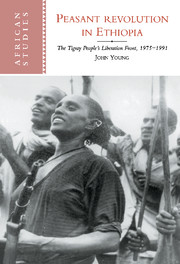Book contents
- Frontmatter
- Contents
- List of maps
- A note on names, transliteration and the Ethiopian Calendar
- Acknowledgements
- 1 Ethiopia
- Introduction
- 1 Peasants and revolutions: theoretical directions
- 2 Historical and social background
- 3 Tigray on the eve of insurrection
- 4 Struggle for opposition ascendancy: 1975–1978
- 5 Challenges and advances: 1978–1985
- 6 Triumph 1985–1991
- 7 TPLF and the peasants
- 8 Conclusion
- Notes
- Bibliography
- Index
- Titles in the series
Introduction
Published online by Cambridge University Press: 12 November 2009
- Frontmatter
- Contents
- List of maps
- A note on names, transliteration and the Ethiopian Calendar
- Acknowledgements
- 1 Ethiopia
- Introduction
- 1 Peasants and revolutions: theoretical directions
- 2 Historical and social background
- 3 Tigray on the eve of insurrection
- 4 Struggle for opposition ascendancy: 1975–1978
- 5 Challenges and advances: 1978–1985
- 6 Triumph 1985–1991
- 7 TPLF and the peasants
- 8 Conclusion
- Notes
- Bibliography
- Index
- Titles in the series
Summary
My interest in Ethiopia, and specifically the northern province of Tigray, developed during the course of my tenure as a journalist for The Sudan Times between 1986 and 1989 in Khartoum, a city which hosted many thousands of Eritrean, Tigrayan, and other Ethiopian refugees and their political organisations. Unlike an earlier generation of Western scholars who were drawn to the study of Ethiopia because of the country's ancient history, fascinating cultures, absence of a colonial tradition, or the person of Emperor Haile-Selassie, I was attracted by the epochal scope of the struggles the Eritreans and Tigrayans were engaged in, and the determination and sophistication which they brought to them.
Editorially The Sudan Times had strong sympathies for the peoples of southern Sudan and I closely followed the revolt of the Sudan People's Liberation Movement (SPLM) which, like the revolts of the Eritrean People's Liberation Front (EPLF) and Tigray People's Liberation Front (TPLF), was for national self-determination and opposed by a hegemonic state. However, while these movements shared conditions of national oppression and resistance, they were in many ways very different. The fact that the SPLM was a significant beneficiary of the government that the EPLF and TPLF were dedicated to overthrowing, while various Sudanese governments provided erratic support for the latter movements, was one such difference, but it was not critical.
- Type
- Chapter
- Information
- Peasant Revolution in EthiopiaThe Tigray People's Liberation Front, 1975–1991, pp. 1 - 15Publisher: Cambridge University PressPrint publication year: 1997

